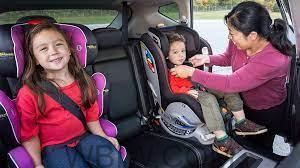
INDIANA — Car crashes are a leading cause of death for children across the U.S. According to national data, an average of two kids under 13 were killed every day in collisions in 2020. Of the total fatalities that occurred, 42% were unrestrained. In Indiana, 20 children lost their lives in passenger vehicle crashes that year.
Many times, injuries and deaths can be prevented with the proper use of car seats, boosters, and seat belts. When used and installed correctly, a car seat can reduce the risk of fatal injury by 71% for infants and by 54% for toddlers.
However, statistics show that nearly half (46%) of car seats are misused – leaving kids more vulnerable in a crash.
To address this, the Indiana Criminal Justice Institute (ICJI) is encouraging parents and caregivers to take time during Child Passenger Safety Week (Sept. 18-24) to make sure their child is properly secure in an appropriate car or booster seat.

“It’s our job, as parents, to keep our kids as safe as possible when traveling,” said Devon McDonald, ICJI Executive Director. “At a minimum, this means being educated on car seat safety and making sure kids are buckled up correctly. If there’s any doubt, get in touch with a certified professional as soon as possible.”
With the amount of car seat choices on the market today, finding the right one can be challenging. Not all car seats fit in all vehicles, and there are important factors to take into consideration, such as making sure the seat is age- and size-appropriate.

Parents and caregivers in need of assistance are encouraged to contact a certified Child Passenger Safety Technician. These individuals are specially trained in car seat installation, best practices, and education, and offer support and guidance to motorists with children, free of charge. They can also register car seats and check for recalls.
Safety checks are available year-round on an appointment-only basis and typically take 20-30 minutes. Those visits can be conducted virtually or at one of Indiana’s 100 fitting stations, which can be found by visiting: on.in.gov/SafeKids.
ICJI Traffic Safety Director Robert Duckworth, who was appointed to the National Child Passenger Safety Board earlier this year, recommends having an inspection done even if the car seat is thought to be installed correctly.

“It never hurts to get a second opinion or advice from an expert,” Duckworth said. “Our technicians are highly trained, highly skilled, and have years of experience, so even if you’ve done your research, you’re guaranteed to walk away with some useful knowledge. That extra step could end up saving a life.”
The National Highway Traffic Safety Administration provides a list of free, online resources to assist parents in finding the right seat for their child’s age and size. The website also includes mistakes to avoid, with one of the most common being moving a child to the next seat or position too soon.
“Keeping kids in a car seat for as long as possible and in the back seat are two of the safest things parents can do, outside of never letting them ride unbuckled,” McDonald said. “Even if it’s a short distance, the consequences of that decision could be devastating.”
Indiana law requires all occupants and children to be properly buckled in. For kids under the age of 8, that means riding in a correctly installed car or booster seat.
There’s a common misconception that certain types of vehicles, such as a truck or SUVs, may offer greater protection for child passengers. A bigger vehicle doesn’t mean extra protection or that a child can ride unbuckled, according to ICJI.
It’s also important, with colder weather around the corner, for parents to know that heavy coats can interfere with the proper harness fit on a child in a car seat. The best practice is to pick thin, warm layers and place blankets or coats around the child after the harness is snug and secure for extra warmth.
Parents should refer to their car seat manufacturer’s instructions and vehicle owner’s manual for installation assistance.
For more information on car seat safety, visit www.nhtsa.gov. For a free online course on car seat basics, click here.



